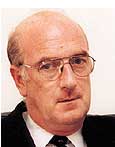 |
Editorial |

 D.R
D.R |
 |
Network news |

 |
Life on the canals |

 |
News in brief |


|
|

|
|
| |
editorial
Congratulations, VEV !
|

Regularly informed of the VEV project and its progress, I am honoured
to be given the opportunity to address the network as president
of Inland Waterways International.
The association, which counts among its membership waterway authorities,
associations, professionals and individuals from 15 countries, was
founded to promote inland waterways throughout the world. In addition
to playing what we hope is a valuable role in the world canal conferences
held each year, by guaranteeing continuity of the debates and the
messages that are disseminated, we lend our support to projects
which, in line with the philosophy of your network, aim to maintain
and operate the canals for the greatest benefit to the community.
This involves making the public aware of the value of waterways
for a whole range of activities, from cruising and boat trips to
simply walking along the towpath.
Our association also recommends the rehabilitation of waterways
that have fallen into disuse, wherever the validity of this choice
can be proven, and uses its influence in support of such projects.
The way the situation is evolving on the projects we are monitoring
in many countries suggests that these limits are being pushed further
and further! As a caricature, I would say that what appeared yesterday
to be unrealistic has today become possible and perhaps in some
cases urgent!
We are thus particularly heartened by the progress on the founding
projects that are specifically assisted by VEV programme: opening
within two years of the Millennium Link, conservation of the unique
environment and heritage of the Paderno Canal, restoration of navigation
of the Tarn circuit based on the Canal des Deux Mers, continued
operation of the hydraulic lifts on the Canal du Centre, etc. We
are also delighted to hear about the link-up between the two Terra
programmes VEV and Grootstad, in favour of a major cross-border
urban project around restoration of the Roubaix Canal, a waterway
saved from infilling in the 1980s thanks to pressure from anglers
and several of our founder members (see article).
This exchange augurs well for opening of the VEV network to a wider
partnership, for which I am sure that the authorities in my country
(Republic of Ireland) will be particularly enthusiastic. Since reopening
of the Shannon-Erne waterway in 1994 (a major project financed 50%
by the ERDF), there have remained in Ireland many challenges to
be tackled to ensure dynamic, balanced development throughout the
canal network, under the auspices of Waterways Ireland, which I
believe is the first navigation authority in the world to have control
over waterways in two separate jurisdictions. Their aim is not simply
to reopen the various former links (Royal Canal, Ulster Canal, Newry
Canal,...) but above all to make these canals live throughout the
year, for local development that will bring employment, as well
as being an object of identification and a sense of pride among
the regional population.
What the Shannon-Erne link has succeeded in doing in a backward
rural region is quite remarkable, and indirect impacts have well
exceeded all the projections. However, before we can say we have
similarly succeeded in Dublin, in its docks and on the canals, along
the Royal Canal, much effort is still required, and we would be
delighted if the widened VEV network gave us the opportunity to
exchange with you all, to improve our projects and make them perform
better under all headings: social, employment, sustainable development.


D.R
|

|
Des
LEYDEN
Président Inland Waterways International
|

|
|
|
